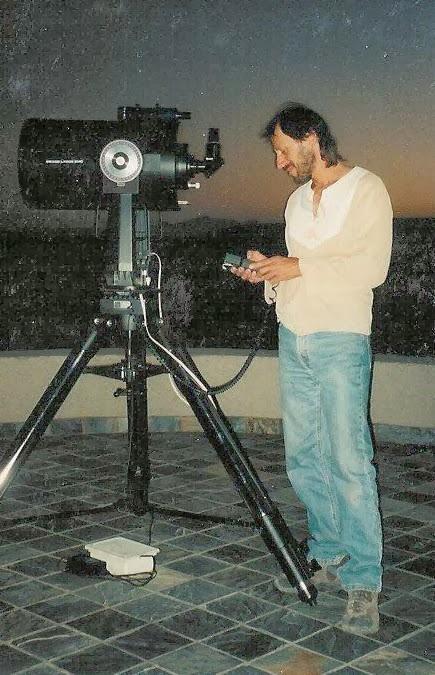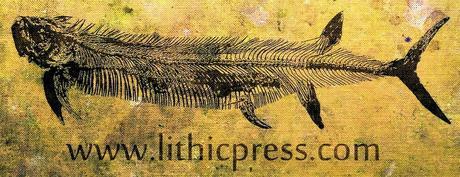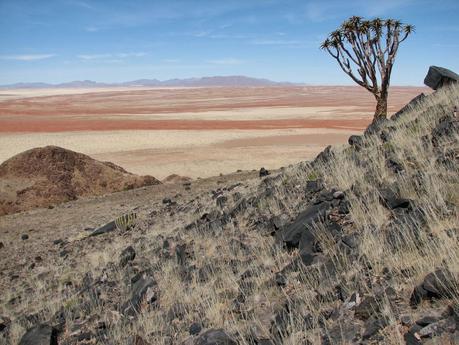
Quiver tree on Cambrian/Precambrian dolomite overlooking dunes of the Namib Sand Sea.
Guest post by astronomer, geologist, poet and good friend Danny Rosen.
From 2003 - 2008, for a few months a year, I ran an observatory and taught astronomy and geology in the Namib Desert in far southwestern Africa. I wrote this poem during a period of observing the best sky I’d ever seen every night for three months. There was essentially no light pollution. The Southern Cross, Alpha Centauri and the southern Milky Way were enough, but going deeper into the sky with a fine telescope was life changing. The poem sprouted when I began sleeping under the telescope to more easily wake for pre-sunrise viewing. I got caught up in the rising and lowering of the horizons, the planetary spin, and at some point imagined the eye of a Nautilus at the center of its spiral looking out -- like the human eye in the Milky Way.
As astronomer in residence I stayed up later than anyone and walked back to my room alone. There were animals about, and endless stories of rough encounters, some nearby, not all were just legend. I heard footsteps all the time and set folding chairs around my head to keep curious hyenas away. Lured by CO2, they are known to take investigative face bites of unwary campers.The center of our galaxy is in the direction of the constellation Sagittarius. It’s dense that way: fields of stars, clusters of stars (butterfly, coathanger, jewell box), nebula seen with the naked eye, and the big and small Magellanic Clouds, spinning around. From Namibian latitudes this area of the sky is especially bright -- seen almost straight overhead, where we look through the least of our atmosphere, the stars are most clear. (We can see Sagittarius from mid-northern latitudes but it never gets very high above the southern horizon -- so, we look through a thicker slice of the atmosphere and the view is not as sharp.) That’s a good reason in itself to travel south.Paul Theroux, in Dark Star Safari, wrote that V. S. Naipaul helped him see the comedy of Africa. Tragedy is more obvious with all the difficulties of the post-colonial period, and ever burgeoning and needy populations. People die young, life goes on, there is laughter and song, silly things are done, vehicles get stuck in the sand, there are difficulties with the hi-lift jack ...
It’s a hard rock desert canyon landscape inhabited by people whose ancestors go way back, overlain with a European cultural fabric, and a vestige of Pleistocene megafauna. Rhino on the desert floor. Continental knife and fork at the German Club. Eco-lodges with camouflaged diesel generators.
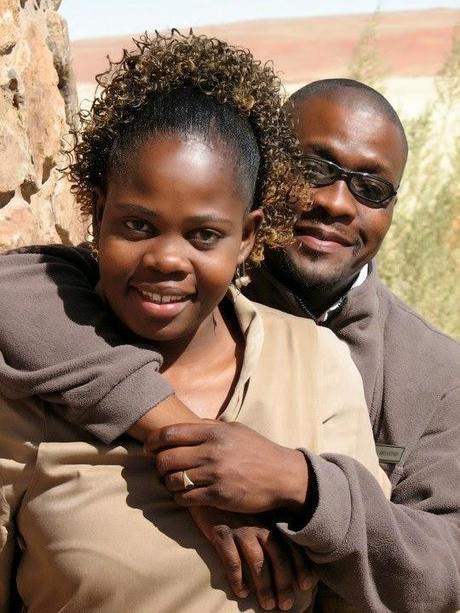
Des with Bev
Your African Fold
The sunrise in your gray eyes speaksthe history of man with no words.Silence spirals across the sky.This nautiloid look from the inside.
Wrapped in saugins and duvet,
with eyes wide against the soundsoutside, trembling at your footstepsin the dawn moonlight, Sossusvlei,I miss your naked eye nebula,your pale chanting evenings,the truth of your false cross.I still see the baboons staringdown the gravel highway I droveall the way to fata morgana herself,her moist finger motioning me to jumpfrom the cliffs of my unspoken east.I can still hear the what-what of yourquick click chit chat this that and the other,tell me another story so hard from the start,far from home, close to the heart. The tragedyof the easy tip, the comedy of the kitchen lip,the opera of the landy stuck in the sandyand old jack hi-boy only knows one way to go.Pull the damned thing out, soundsMr. Basso Profundo, ‘un-air these tires man,get thee out of this godforsaken land.’Godforsaken? Why,here He comes just now, walkingthrough the shadow of a quiver tree,out across the gravel plain, walking on one legwith one arm and one eye that can still findthe road ahead. Namib lands,I’ll sail through your lagoons anytime,and paint butterflies in your sand all night.I’ll lay by your side as you die before your time,and see you rise again with Mimosa. Mimosa,I can still feel the bowl of your soft dark bellyhanging above me every night, tucking me in,rolling me over and over until I’d been rolledinto the arms of your African fold.☆☆☆☆☆Sossusvlei is an area of the central Namib Desert. The name derives from the Nama word "Sossus" -- no return or dead-end -- and the Afrikaans word "Vlei" -- marsh (similar to a playa lake). Gervasius Nangolo, a handyman, was a good friend -- he had gray eyes. Pale chanting goshawks are a common bird of the Namib. The False Cross is an asterism made of stars in the constellations Vela and Carina (part of the mythological ship Argo Navis that Jason sailed on his quest for the golden fleece). Many native people of the Namib, and throughout southern Africa, incorporate clicks into their language. Quick, loud, sharp clicks. Talk radio is great! (here's a cool instructional video).Quiver trees (Aloe dichotoma) almost resemble Joshua Trees but have a more surreal nature. Gravel plains are the desiccated remains of horizontal rock layers that have broken down in place and been transported very little. They are emblematic of how geologically stable the area has been since Gondwanaland broke up and Africa split away from South America 130 million years ago. The “Lagoon” is a nebula in Sagittarius. The “Butterfly” is a star cluster in Scorpius. A “lay-by” is a roadside rest with a picnic table. I spent part of every night with Mimosa -- a star in the Southern Cross. For some reason, I thought the word "saugins" was a kind of blanket or comforter, but when I later looked it up, I couldn’t find it at all. Apparently, I made it up, but kind of liked the sound of it anyway and decided to keep it.
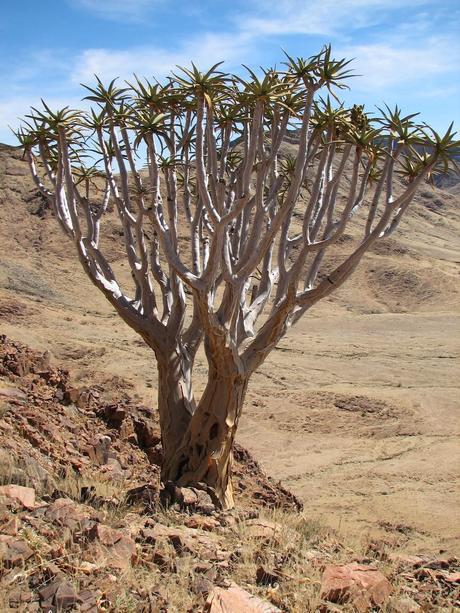
The quiver tree (Aloe dichotoma).
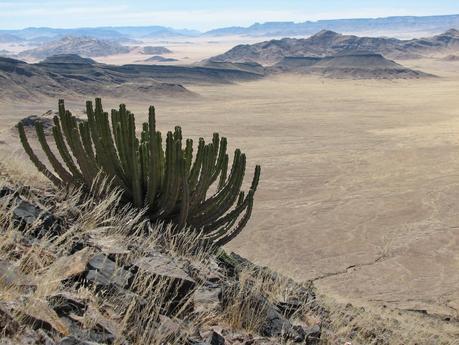
Euphorbia virosa -- the poison tree,
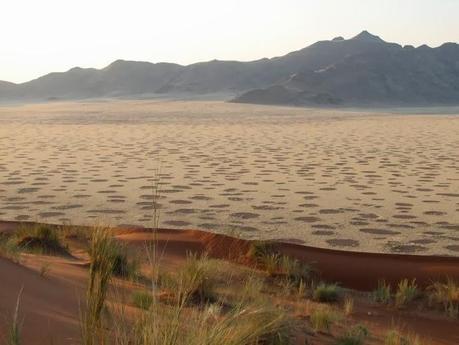
Fairy circles below the Virgin's Nipple. Various explanations for the barren, sandy or gravelly circles in the midst of grassy plains have been proposed over the years, including ants, termites, and grass-killing gas emanating from the soil. A recent hypothesis suggests they're caused simply by plant competition for water and minerals. As University of Wyoming's Doc Mears might have said, probably all these possibilities are true in part.
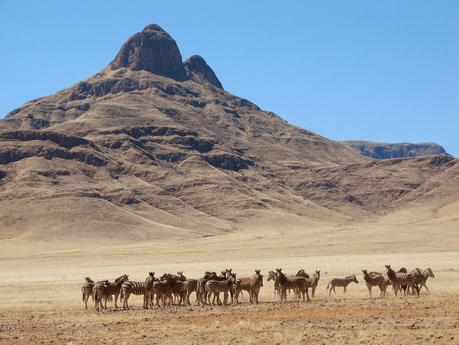
Hartmann's Mountain Zebra, commonly seen on the Namib grasslands.
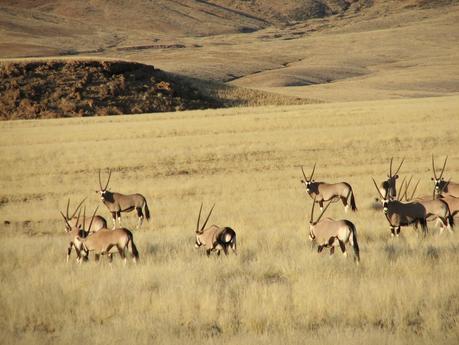
Gemsbok (Oryx gazella) on thick grassland (the area averages less than one inch of precipitation per year). "Oryx" are a signature species of the Namib.
